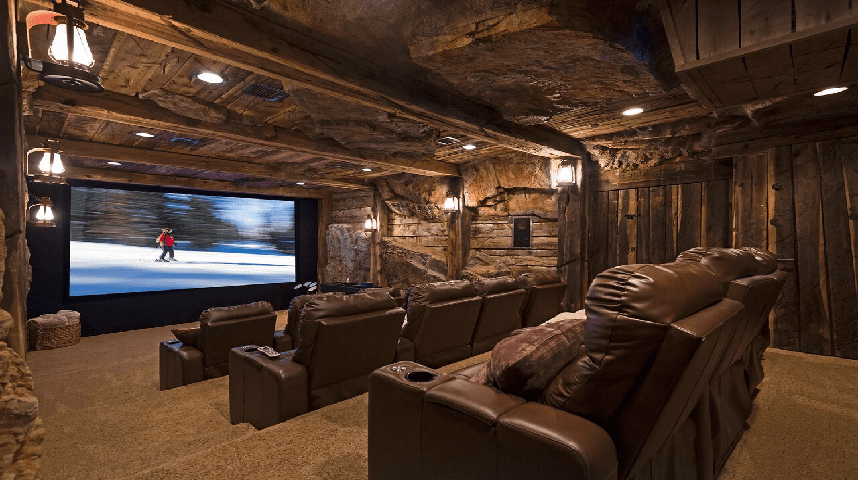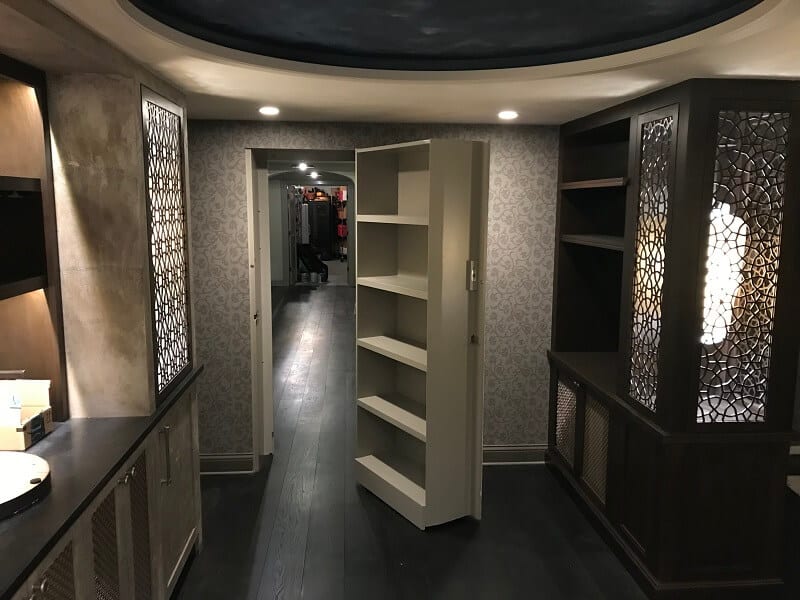
Photo: Charlie Taylor
Escape rooms — where you and your friends are locked into a secret room until you solve the clues — may be a fun night out. But have you thought about building a secret room in your home?
You’ve probably seen the revolving bookcase that revealed a hidden room in The Addams Family or Young Frankenstein. Or maybe you remember the secret painting that hides the entrance to the Gryffindor dorm in the Harry Potter movies. Or perhaps the steel door that hid the escape room in the Panic Room movie. Possibly because they’re so popular on TV and in movies, some custom home buyers are opting for hidden rooms in their homes.
“I like to call them ‘Scooby Doo’ doors,” says Bob Zuber, a partner with Morgante Wilson Architects in Evanston, Ill., who has designed several revolving bookcase doors for clients that lead to secret rooms. “We’re putting them into larger homes, mostly because people think it’s cool and a whimsical feature. But people also like the idea of having a private space for themselves and they like hidden rooms for security reasons, too.”
‘Scooby Doo’ Doors for Home Offices and Man Caves
One of Zuber’s favorite recent projects was designing a bookshelf door for a master suite.
“The door is operated by pulling out a book, just like in cartoons,” Zuber says. “This is a vacation home where the owners entertain often but the husband sometimes needs to work when he’s there. The bookshelf door opens into his office and gives him access to the entire master suite, including a sitting room where he can do conference calls without disturbing any of the guests.”

Zuber says he’s designed about half a dozen escape rooms, three or four of which function as true “panic rooms” lined in steel with a secure phone line and heating and air conditioning.
“We designed one that started as a fun detail, a hidden room with access through a locked door from the basement, a trick bookcase in the first-floor home office and through a hidden door in the second-floor master bedroom closet,” Zuber says. “After the homeowners’ friend was robbed, the project turned into something a little more serious with tighter security.”
Purely for fun, another client had Zuber design a “Scooby Doo” bookcase in what had been a basement exercise room.
“The bookcase opens into a man cave where the homeowner and his friends like to listen to the Grateful Dead, throw darts and drink scotch without anyone being able to see them when the bookcase is closed,” Zuber says.
According to Zuber, installing a secret bookcase door costs from $5,000 to $10,000 depending on the cabinetry, but part of that would have been spent anyway on a bookcase. Since these are usually large homes that cost more than $1 million or are undergoing an extensive, expensive renovation, the cost of adding a secret door to an escape room is a tiny part of the budget.
“We can build a secret entrance behind paneling, art, a mirror or a cabinet,” he adds.
Silver Mine Hides Children’s Bunk Rooms
The owners of a Park City, Utah, vacation home decided to get creative with the children’s wing and home theatre, says Charlie Taylor, a managing partner with The Agency real estate brokerage in Park City.
“Park City is an old silver mining town, so the owners designed a small, dark entrance that looks like a mineshaft from the living room,” Taylor says. “There’s only a little glow in the distance, which raises visitors’ curiosity.”
The entrance to the “mineshaft” is constructed from authentic-looking man-made stone walls and big timber beams that were aged, broken and burnt to look weathered. Old mine lanterns were converted into wall sconces and the owners even added a little bird cage for the proverbial canary in the mine. Overhead, the dark-painted ceiling includes fiber-optic lighting to look like the night sky, including the Big Dipper and the Little Dipper.
“Inside the ‘mine’ are two cabins built with reclaimed wood, which are the boys’ and girls’ bunk rooms for kids and grandkids and their friends,” Taylor says. “Deeper in the ‘mineshaft’ is a wood door that says ‘Keep Out’ and a fake box labeled TNT with a plunger.”
The “mine” also includes a home theater that continues the theme, with big beams overhead and bits of real silver embedded in the synthetic stone walls, which appear to be made of boulders.
Mirror, Mirror on the Wall: Which One Hides the Safe Room?
The more serious side of escape rooms are safe rooms designed to keep jewelry and other valuables — as well as the homeowners — secure in case of a home invasion.
“We’re seeing a bubbling up of requests for secret rooms from our custom home customers,” says Mary Cook, principal of Mary Cook Associates, a commercial interior design firm in Chicago. “People who have something special that they need to protect like to find innovative ways to solve the problem.”
Cook knows a historian with an extensive collection of Civil War memorabilia.
“One part of a bookcase in his house rotates 90 degrees to open into a room with glass cases like a museum,” Cook says. “The hidden door keeps his collection hidden from view when people come to the house and it’s also a fun feature. You can hang out in the secret room and have a glass of wine, smoke a cigar and look at the collection.”
Cook designed a secure room off the master bedroom for one of her clients that functions as a room-size safe for their jewelry and other items. The 8-by-8-foot room is large enough for them to hide if necessary.
“We designed the bedroom with two large matching framed mirrors, but one of the mirrors has a hidden hinge that opens the mirror and reveals a heavy locked metal door to the safe room,” Cook says. “When you look at the mirrors, you’d never guess that there’s a room behind one of them.”

Michele Lerner is an award-winning freelance writer, editor and author who has been writing about real estate, personal finance and business topics for more than two decades.

 How Historical Homes Can Inspire Your New Home
How Historical Homes Can Inspire Your New Home